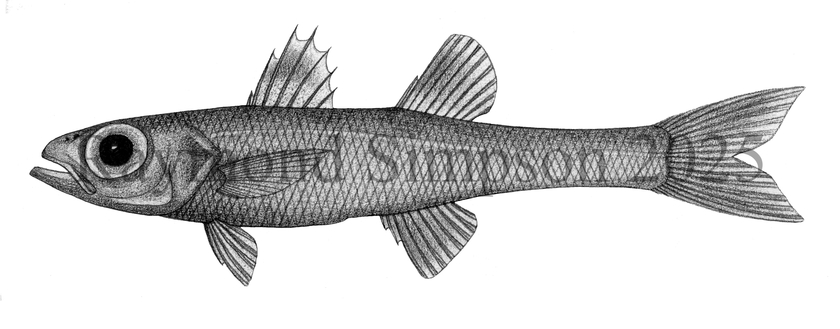
Common Name
Pencil Cardinalfish
Year Described
Dieuzeide, 1950
Identification
Dorsal Fin: VII-1, 10 (rarely 9)
Anal Fin: II, 9 (rarely 8)
Pectoral Fin: 18-19
Lateral Line: 46-49
Gill Rakers: 26-34 (first arch)
Vertebrae: 10+15 = 25 total
Body slender and laterally compressed. Body depth 15.8-23.6% SL. Caudal peduncle length 25.9-33.1% SL. Large terminal mouth. Teeth conical. Lingual and endopterygoid teeth absent (rarely a few random teeth on tongue). No enlarged teeth present at lower jaw symphysis. Maxillary process absent. Opercular spine absent. Opercular margin serrated. Pyloric caeca 10-14. Ribs present on last abdominal vertebrae. First dorsal spine small (less than half length of second). Body scales deciduous and ctenoid. Lateral line complete and composed of pored scales. No luminous organ on belly.
Color
Body grayish-brown on the dorsum with a silvery flank and whitish belly. Fins with dark membranes and paler tips and bases. Mouth light. Gills area dark.
Size
Maximum size to 187.5 SL.
Habitat
Occurs near hard bottoms and walls from 200-830m but usually 300-600m.
Range
Nova Scotia to the S. Caribbean, including the Gulf of Mexico.
References
Mayer, G. F. 1974. A revision of the cardinalfish genus Epigonus (Perciformes, Apogonidae), with descriptions of two new species. Bulletin of the Museum of Comparative Zoology v. 146 (no. 3): 147-203.
Okamoto, M., Baldwin, C. C., & D. J. Long. 2024. Two new species of the deepwater cardinalfish genus Epigonus (Epigonidae) from deep reefs off Curaçao, southern Caribbean. Ichthyological Research, 71(3), 1–10.
Okamoto, M., D. J. Long, R. Claro, & J. E. McCosker. 2025. A new species of epigonid fish genus Epigonus (Teleostei: Epigonidae) from Cuba and the first records of E. fragilis from the western South Pacific and Taiwan. Ichthyological Research, 1-10.
Ruiz-Pico, S., J. C. Arronte, A. Punzón, A. Serrano, F. Velasco, & O. Fernández-Zapico. 2012. First records of Epigonus denticulatus (Perciformes: Epigonidae) in the northern waters of Spain: northernmost occurrences in the eastern North Atlantic. Cybium, 36(4), 578-580.
Other Notes
A member of the Epigonus pandionis complex and closest to E. pandionis itself, differing in body depth, caudal peduncle length and expression of a dark ring on the caudal peduncle.